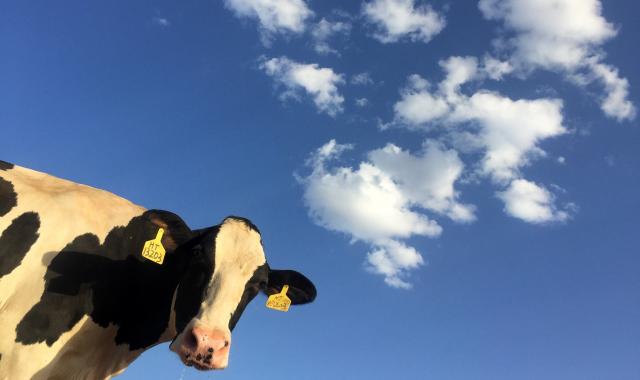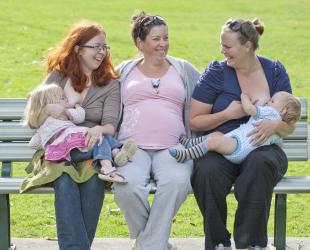Talking breastfeeding with special guest Prof. Wendy Ingman
Nicole talks with Professor Wendy Ingman about her research and work as a mammary gland biologist. We learn about interesting aspects of lactation in mammals, including the fascinating Tammar Wallaby. The signs and symptoms of mastitis in humans is discussed as well as what mums can do if they develop mastitis. Wendy also answers the question, ‘Are we just like cows?'.

Podcast episode
Podcast information
Talking breastfeeding with special guest Prof. Wendy Ingman
Nicole talks with Professor Wendy Ingman about her research and work as a mammary gland biologist. We learn about interesting aspects of lactation in mammals, including the fascinating Tammar Wallaby. The signs and symptoms of mastitis in humans is discussed as well as what mums can do if they develop mastitis. Wendy also answers the question, ‘Are we just like cows?'.
Information discussed in this episode:
- Mastitis
- Purchase our booklet, Breastfeeding: breast and nipple care
- World Health Organization, Mastitis : causes and management
- Breastfeeding and prescription medications
- Hand expressing videos
- Looking after yourself
- Breastfeeding through pregnancy and beyond (tandem feeding)
Credits:
This episode is presented by Nicole Bridges. Featuring Prof. Wendy Ingman.
Audio editing by Jessica Leonard. Show notes by Belinda Chambers. Transcription by Madina Hajher. Produced by Belinda Chambers, Jessica Leonard and Eleanor Kippen.
[Music in background]
WENDY: when we start looking at mastitis you’ve got to think about where we’ve come from. We started with understanding mastitis really largely through our research in the dairy industry.
NICOLE: Welcome to Breastfeeding…with ABA, a podcast brought to you by volunteers with the Australian Breastfeeding Association. Breastfeeding…with ABA is a podcast about breastfeeding, made by parents for parents. In this episode we’ll be talking about a breast infection called mastitis with some handy hints on how to treat it.
We are recording this podcast from different parts of Australia. We acknowledge the traditional owners of the lands on which we are recording this podcast and on which you are listening. We pay our respects to indigenous elders, past, present and emerging and especially any Aboriginal people who may be listening today. We also acknowledge the indigenous women of Australia who have been living, working, birthing, and breastfeeding, and raising children successfully on this country for tens of thousands of years.
My name is Nicole and I’m a volunteer breastfeeding counsellor and community educator with the Australian Breastfeeding Association. I am speaking from my home on the lands of the Darrug people in western Sydney, New South Wales. I have three children, two daughters and one son and they are currently aged between 10 and 21 years. I’m here today with Dr Wendy Ingman who is the THRF associate professor of breast cancer research at the University of Adelaide. Welcome Wendy.
WENDY: Thank you, Nicole.
NICOLE: Dr Ingman is a mammary gland biologist and her approach to breastfeeding is going to come from that perspective. Wendy perhaps you can tell me what it means to be a mammary gland biologist because that’s a term we don’t hear very often.
[music fades]
WENDY: Biology is the study of life and so as a mammary gland biologist I study how the different cells in the breast communicate with each other and how they work together to produce milk during lactation. I also study the underlying biology of how disease states in the breast develop, such as mastitis. We as mammals are one of 5000 different species which use mammary glands to make milk to provide nourishment to our offspring.
NICOLE: So, Wendy we hear a lot about mastitis, I know often when we’re talking to mothers antenatally or prenatally, one of their biggest fears is that they’ll get mastitis. But what exactly is it and how can that impact on breastfeeding?
WENDY: Mastitis is inflammation of the breast, and it often appears as a redness or a pain in the breast. It is accompanied by systemic symptoms such as a fever, or chills, aches, and flu like symptoms. It can range from being quite mild to severe, requiring hospitalisation; it can lead to breast abscess as well in a small percent of cases. So, it is a disease which needs to be taken seriously; it can also occur quite rapidly. It’s accompanied by a reduction in milk volume as well and it’s incredibly debilitating for women who have a new baby and a lot of stress and perhaps, they’re sleep deprived as well. So, coming down with such an intense series of symptoms is really debilitating. It’s not surprising that there is a fear of the disease in breastfeeding women, and it is a common disease as well. About 1 in 5 women will experience mastitis in the first 6 months after having a baby.
NICOLE: So, Wendy you were saying there were over 5000 different mammal species, do we all actually lactate the same or are there differences?
WENDY: There are a lot of similarities between the mammary glands of different species but there are also some very important differences. Mammals are broken up into 3 different categories, one of which is the eutherian mammals which are placental mammals like ourselves. Most mammals you think of will be eutherian mammals. Then there are marsupials which are the pouch mammals, so kangaroos and koalas nurture their offspring in a pouch. And then there are the monotremes and they’re the egg laying mammals such as the echidna and the platypus. And each of these classes or types of mammals do have differences between how they use lactation to nurture their offspring. There are some really fascinating differences actually, and one of my real fascinations with different mammals is really with marsupials. As Australians, I think, we have a particular connection to marsupials. When you think about marsupial lactation for example, the Tamar Wallaby has been very well studied in terms of its lactation and these wallabies give birth to incredibly underdeveloped young so, they have a gestation length of about 26 days. When the Tamar Wallaby gives birth it is this tiny little pink jellybean, doesn’t have eyes or proper limbs or anything, is hairless and it crawls up into its mother’s pouch where it finds a teat and becomes permanently attached to that teat. It completes the rest of its development, which is nearly a year long, in the pouch using lactation as its source of nutrients for its development. So, it has a very specific strategy for its development which is based very much on lactation and not quite so much on gestation, which is more our strategy. And therefore in order to do that and to undergo such an enormous amount of developmental change across this infant wallaby’s development, the milk composition has to change as the baby grows. So, at the beginning the composition of the milk will support the early development and then as the wallaby becomes older and older, its developmental needs change and the milk actually will change to accommodate that, which is really fascinating. And the Tamar Wallaby also has this incredible ability to undergo asynchronous lactation, where it can be providing milk for a tiny little baby infant using one teat, but also providing more mature milk for an older wallaby or joey, that is in and out of the pouch. So, you know this is really tandem breastfeeding to the extreme. So, I’m absolutely fascinated by marsupial lactation and what we can learn about mammalian lactations by comparing different species.
NICOLE: Yeah, that’s really fascinating, and as much as you’ve obviously outlined and described the big differences between that and human lactation, I can see a lot of similarities, too, in terms of the tandem breastfeeding and that kind of thing. So, that’s really amazing. So, Wendy, are we just like cows?
WENDY: When we start looking at mastitis you’ve got to think about where we’ve come from. We started with understanding mastitis really largely through our research in the dairy industry. The dairy industry is an enormous industry, and really that’s where the focus has been on research for that reason because of the costs associated with mastitis which has been a huge problem. And about 40 years ago there was a huge effort to improve mastitis in dairy cows. There were sweeping changes where there was improved sterilisation of milking equipment, looking at the housing conditions for dairy cows, reducing overcrowding, and culling chronically infected animals. And this had a dramatic impact on the prevalence of mastitis in dairy cows. And what that really pointed to was that the real problem for the dairy industry in terms of mastitis was being driven by bacteria. So pathogenic bacteria, such as staphylococcus aureus and S. uberis and E. coli, were the culprits which were triggering inflammation in the mammary gland of these cows and causing this incredibly debilitating condition, reducing milk supply, and causing a lot of pain and discomfort for those cows.
So, the assumption then that in humans we have the same direct relationship between pathogenic bacteria and mastitis has not really been supported by clinical evidence. As far back as the year 2000, the World Health Organization published a document ‘Mastitis – causes and management’, and they identified this real paradox in our understanding of the relationship between bacterial pathogens and mastitis and noted that there are a lot of women who have severe mastitis who do not have detectable pathogenic bacteria in their milk, or on their skin. And conversely, there are a lot of healthy women who have no problems with lactation, who have quite high levels of pathogenic bacteria in their milk. So, even though we do see pathogenic bacteria associated with mastitis, it is clearly not the only culprit when it comes to mastitis in women. And, when you think about this take a step back and if you think about how we live compared to how dairy cattle live, this isn’t surprising. You know we do not share milking equipment between women, we do not have these crowded housing conditions, so the spread of pathogenic bacteria does not occur similarly in humans as it does in dairy cows. So, we really need to look more closely at what is triggering mastitis, and what the predisposing factors are for mastitis in women and make our recommendations on how to treat mastitis in women based on the clinical evidence that we have for women, not dairy cows.
NICOLE: And as you say it can be extremely debilitating and unfortunately, it’s one of those diseases that does generally affect women when they’re at their most vulnerable. For most women that is just after the birth of the baby when they are often exhausted and tired. So, it’s kind of like a big pile on, it can be difficult enough in those early weeks without that. And I found personally that it can affect individual women very differently and even the same woman very differently each time. I’ve had three children and had it probably about 6 times over 3 lactations and it varied in terms of how quickly it affected me and how debilitating it was as well. So, it can vary a lot, obviously between species but even from one experience to another in the same woman. And as much as it is very debilitating and quite serious the good thing is that it is treatable. I think that’s an important message for mums to hear as well, not to be so scared of it that they don’t breastfeed, or they don’t continue breastfeeding, and if they get onto it quickly, it can be treated.
WENDY: Yeah… where we’re coming from is really understanding what mastitis actually is and not assuming that it is the same disease as we see in the dairy industry and having an awareness of what the risk factors are and how they’re affecting the breast and causing inflammation.
But I should also say, Nicole, that we’re really quite limited in our understanding of mastitis in humans because the research has just not progressed the same way as it has for the dairy industry. Very difficult to get funding for to do the research and, you know, what we keep coming back to when we look at the evidence for what works, there’s not a lot in terms of randomised controlled trials which really show what we should be doing. So, we’re still able to make recommendations and look at how best to manage it, but I do hope that in the future we’ll be able to do a much better job than we are now. And this is where my research is, understanding some of the triggers of mastitis which are not so well understood and what we can do to prevent those triggers from occurring in the first place.
NICOLE: And what would you say to the mothers listening would be signs and symptoms of mastitis that they should be taking notice of?
WENDY: It’s really first and foremost about discomfort in the breast, so, a hot spot, or redness, or a lump. There are a number of predisposing factors that if present could mean you may be developing mastitis. A damaged nipple, or if you’ve missed a feed, so there’s an increase of milk, or a poor attachment. Anything that could be increasing the amount of milk or be preventing proper emptying of the breast, such as n oversupply of milk, or rapid weaning, or having a restriction on the breast such as a tight bra, or a seatbelt for instance. Anything that can prevent some of the flow of milk. So, a build-up of milk that hasn’t been properly removed can increase the risk. As well another one is maternal stress and fatigue which, [laughs] isn’t necessarily something that you can easily avoid.
NICOLE: There’s no medication for that unfortunately, no magic pill.
WENDY: No, and really where we’re coming from when I’m talking about these predisposing factors is the build-up of milk which hasn’t been expressed, and this is really one of the important triggers of mastitis which my research has really focussed on. Rather than take the approach that there’s bacteria there, and they’re the culprits, we can look at the build-up of milk which is causing mechanical stretch and stress in the breast and triggering inflammation in the breast which may or may not be associated with those pathogenic bacteria. And our research is starting to suggest that part of the issue with mastitis is the body’s own response to that build-up of milk. There are some women who have very sensitive immune systems to the triggers and when inflammation is triggered in the breast, they get these mastitis symptoms. This can even create a breeding ground for the bacteria that are present as well. So, bacteria can still be present, and they can still be part of the disease but they’re not necessarily the triggers of it.
NICOLE: That’s really fascinating. What would we say to a mother in terms of treatment, what should she do if she’s experiencing these symptoms?
WENDY: I think the first thing is the focus on removal of milk from the breast. Breastfeeding more often, getting some help to improve attachment to make sure that the milk is being emptied from the whole breast, not just part of it, massage to help to clear, if there’s a blocked duct, and also expressing milk after feeding. I know that these are not always the things that help women. There’s some blocked ducts that no matter what someone does it doesn’t clear. But they’re the kinds of approaches that we can try to get the milk flowing and I think that’s probably one of the most important things.
And then also supportive measures, these are things like getting lots of rest, and looking after yourself, and going easy on yourself. Drinking fluids, eating right, and if needed hospitalisation. When this gets to that stress and fatigue, taking this seriously, getting help, and getting support for a condition which really is debilitating. You need to take time to look after yourself as well as looking after your baby and looking after everyone else.
This guidance comes from the Academy of Breastfeeding Medicine who published about mastitis in 2014, and if you’re interested in finding out more about their recommendations you can search for them online. That document is available for you to have a look at.
NICOLE: Yeah well, I mean one of the first things I always recommend to mums who suspect they have mastitis is go to bed with the baby, just go to bed and feed, feed, feed. As we know that can be so difficult for new mums sometimes, particularly if they might be at home alone or they’ve got a partner who’s working out of the home. They might have other children they’re looking after as well, and often you know, as women we tend to not be very good at putting ourselves first, and not looking after ourselves either.
WENDY: But maybe after listening to this podcast, you’ve heard it here. The third thing is as well is of course, pharmacological management, analgesia; so, anti-inflammatories, perhaps ibuprofen might be a bit better, simply because it is an anti-inflammatory as well as being an analgesic. And antibiotics, you know, I wouldn’t ever dismiss the role of antibiotics in mastitis management; if symptoms don’t improve within 12-24 hours, or if the woman is really acutely ill, then antibiotics would be recommended as well.
[Music fades in]
NICOLE: Well, thank you very much for spending some time chatting with me today, it’s been really fascinating and I’m sure that anyone listening will learn something new as I have.
WENDY: I hope so.
END
- Access our free info kit.
- Download our mum2mum app via the App store or Google Play.
- Call the National Breastfeeding Helpline on 1800 686 268, available 24 hours a day, 7 days a week.
- Chat with a volunteer via LiveChat on our website.
- Sign up for an interactive and informative local breastfeeding class or online breastfeeding workshop.
- Get books and resources on general and specialist breastfeeding topics.
- Join ABA as a member to get your free copy of our best-selling book Breastfeeding … naturally + free access to all premium content on the mum2mum app + discounted breastfeeding classes + half-price breast pump hire + unlimited access to ABA events + more!



